Charité
|
Charité – Universitätsmedizin Berlin | |
 | |
| Motto | Forschen, Lehren, Heilen, Helfen |
|---|---|
Motto in English | Researching, teaching, healing, helping |
| Type | Public |
| Established | 1710 |
| Budget | € 1.474 billion[1] |
| Chairman | Karl Max Einhäupl |
Academic staff | 4,401[1] |
Administrative staff | 8,521[1] |
| Students | 6,792[1] |
| Location | Berlin, Germany |
| Campus | Urban |
| Affiliations |
Freie Universität Berlin Humboldt University of Berlin |
| Website |
www |
The Charité – Universitätsmedizin Berlin is Europe's largest university clinic, affiliated with Humboldt University and Freie Universität Berlin.[2] With numerous Collaborative Research Centers (CRC) of the Deutsche Forschungsgemeinschaft, including three Nobel Prize laureates working as research fellows in the Einstein Foundation, it is one of Germany's most research-intensive medical institutions. From 2012 to 2017, it was ranked by Focus as the best of over 1000 hospitals in Germany.[3][4] More than half of all German Nobel Prize winners in Physiology or Medicine, including Emil von Behring, Robert Koch and Paul Ehrlich, worked at the Charité.[5] Its medical school is one of the most prestigious and competitive in Germany with admission rates lower than 5%.[6]
History

Complying with an order of King Frederick I of Prussia from November 14, 1709, the hospital was established north of the Berlin city walls in 1710 in anticipation of an outbreak of the bubonic plague that had already depopulated East Prussia. After the plague spared the city, it came to be used as a charity hospital for the poor. On January 9, 1727, Frederick William I of Prussia gave it the name Charité, meaning "charity".[7]
The construction of an anatomical theatre in 1713 marks the beginning of the medical school, then supervised by the collegium medico-chirurgicum of the Prussian Academy of Sciences.[8]
After the University of Berlin (today Humboldt University) was founded in 1810, the dean of the medical college Christoph Wilhelm Hufeland integrated the Charité as a teaching hospital in 1828.
Organization
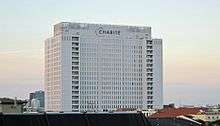
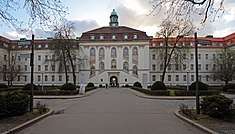

The Charité has four different campuses across the city of Berlin:
- Campus Charité Mitte (CCM) in Mitte, Berlin
- Campus Benjamin Franklin (CBF) in Lichterfelde, Berlin
- Campus Virchow Klinikum (CVK) in Wedding, Berlin
- Campus Berlin Buch (CBB) in Buch, Berlin
In 2001, the Helios Clinics Group acquired the hospitals in Buch with its 1,200 beds. Still, the Charité continues to use the campus for teaching and research and has more than 300 staff members located there. The Charité encompasses more than 100 clinics and scientific institutes, organized in 17 different departments, referred to as Charité Centers (CC):
- CC 1: Health and Human Sciences
- CC 2: Basic Sciences (First Year)
- CC 3: Dental, Oral and Maxillary Medicine
- CC 4: Therapy and Research
- CC 5: Diagnostic Laboratory and Preventative Medicine
- CC 6: Diagnostic and Interventional Radiology and Nuclear Medicine
- CC 7: Anesthesiology, Operating-Room Management and Intensive Care Medicine
- CC 8: Surgery
- CC 9: Traumatology and Reconstructive Medicine
- CC 10: Charité Comprehensive Cancer Center
- CC 11: Cardiovascular Diseases
- CC 12: Internal Medicine and Dermatology
- CC 13: Internal Medicine, Gastroenterology and Nephrology
- CC 14: Tumor Medicine
- CC 15: Neurology, Neurosurgery, Psychiatry
- CC 16: Audiology/Phoniatrics, Ophthalmology and Otolaryngology
- CC 17: Gynecology, Perinatal, Pediatric and Adolescent Medicine with Perinatal Center & Human Genetics
Overall, 13 of those centers focus on patient care, while the rest focuses on research and teaching. The Medical History Museum Berlin has a history dating back to 1899. The museum in its current form opened in 1998 and is famous for its pathological and anatomical collection.[9]
Notable people

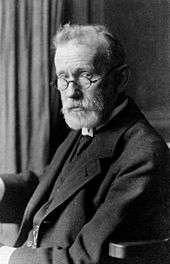
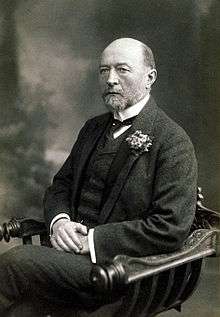
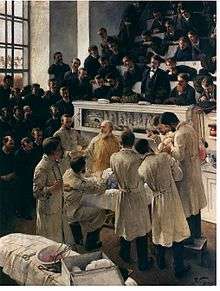
Many famous physicians and scientists worked or studied at the Charité. Indeed, more than half of the German Nobel Prize winners in medicine and physiology come from the Charité.[10] Forty Nobel laureates are affiliated with Humboldt University of Berlin and five with Freie Universität Berlin.
- Joachim Friedrich Henckel – surgeon
- Selmar Aschheim – gynecologist
- Heinrich Adolf von Bardeleben – surgeon
- August Bier – surgeon
- Max Bielschowsky – neuropathologist
- Theodor Billroth – surgeon
- Hans Gerhard Creutzfeldt – neurologist and neuropathologist
- Johann Friedrich Dieffenbach – surgeon
- Friedrich Theodor von Frerichs – pathologist
- Robert Froriep – anatomist
- Wilhelm Griesinger – psychiatrist and neurologist
- Hermann von Helmholtz – physician and physicist
- Friedrich Gustav Jakob Henle – physician, pathologist and anatomist
- Eduard Heinrich Henoch – pediatrician
- Otto Heubner – pediatrician
- Rahel Hirsch – first female medical professor in Prussia
- Erich Hoffmann - dermatologist
- Anton Ludwig Ernst Horn – psychiatrist
- Gero Hütter – hematologist
- Friedrich Jolly – neurologist and psychiatrist
- Friedrich Kraus – internist
- Bernhard von Langenbeck – surgeon
- Karl Leonhard – psychiatrist
- Hugo Karl Liepmann – neurologist and psychiatrist
- Leonor Michaelis – biochemist and physician
- Hermann Oppenheim – neurologist
- Samuel Mitja Rapoport – biochemist and physician
- Moritz Heinrich Romberg – neurologist
- Ferdinand Sauerbruch – surgeon
- Curt Schimmelbusch – physician and pathologist
- Johann Lukas Schönlein – physician and pathologist
- Theodor Schwann – zoologist
- Ludwig Traube – physician and pathologist
- Rudolf Virchow – physician, founder of cell theory and modern pathology
- Carl Friedrich Otto Westphal – neurologist and psychiatrist
- Carl Wernicke – neurologist
- August von Wassermann – bacteriologist
- Caspar Friedrich Wolff – physiologist
- Bernhard Zondek – endocrinologist
Nobel laureates
- Emil Adolf von Behring – physiologist (Nobel Prize in Physiology or Medicine in 1901)
- Ernst Boris Chain – biochemist (Nobel Prize in Physiology or Medicine in 1945)
- Paul Ehrlich – immunologist (Nobel Prize in Physiology or Medicine in 1908)
- Hermann Emil Fischer – chemist (Nobel Prize in Chemistry in 1902)
- Werner Forssmann – physician (Nobel Prize in Physiology or Medicine in 1956)
- Robert Koch – physician (Nobel Prize in Physiology or Medicine in 1905)
- Albrecht Kossel – physician (Nobel Prize in Physiology or Medicine in 1910)
- Sir Hans Adolf Krebs – physician and biochemist (Nobel Prize in Physiology or Medicine in 1953)
- Fritz Albert Lipmann – biochemist (Nobel Prize in Physiology or Medicine in 1953)
- Hans Spemann – embryologist (Nobel Prize in Physiology or Medicine in 1935)
- Otto Heinrich Warburg – physiologist (Nobel Prize in Physiology or Medicine in 1931)
Medical school
In 2003 the Berlin city and state House of Representatives passed an interim law unifying the medical faculties of both Humboldt University and Freie Universität Berlin under the roof of the Charité.[11] Since 2010/11 all new medical students have been enrolled on the New Revised Medical Curriculum Programme with a length of 6 years.[12] Referred to the points needed in the German Abitur to get directly accepted, the Charité is together with Heidelberg University Medical School Germany´s most competitive medical school (2016).[13] The overall admission rate is lower than 5% and comparable to Ivy League Universities in the USA.[6] 3,17% of all Charité Medical School students are supported by the German Academic Scholarship Foundation, the highest percentage of all public German Universities.[14] The Erasmus Exchange Programme offered for Charité Medical School students is the largest in Europe.[15]
International partner universities
- USA: Johns Hopkins School of Medicine, Baltimore
- USA: Northwestern University, Chicago
- Canada: Université de Montréal
- Australia: Monash University, Melbourne
- Japan: Chiba University
- Japan: Saitama Medical School
- Brazil: Universidade de São Paulo
- China: Tongji University, Shanghai
- China: Tongji Medical College, Wuhan
Einstein Foundation
The Charité is one of the main partners of the Einstein Foundation, which was established by the city and state of Berlin in 2009. It is a "foundation that aims to promote science and research of top international caliber in Berlin and to establish the city as a centre of scientific excellence".[16] Research fellows include:
- Thomas Südhof – biochemist (Nobel Prize in Physiology or Medicine in 2013)
- Brian Kobilka – chemist (Nobel Prize in Chemistry in 2012)
- Edvard Moser – neuroscientist (Nobel Prize in Physiology or Medicine in 2014)
Films
- Charité, German television series
References
- 1 2 3 4 "Leistungsbericht der Charité – Universitätsmedizin Berlin über das Jahr 2015 zur Umsetzung des Charité-Vertrags 2014 bis 2017" (PDF) (in German). p. 40. Retrieved 2017-06-15.
- ↑ "Charité – Universitätsmedizin Berlin Geschichte".
- ↑ "Charité bestätigt Spitzenposition als "Deutschlands beste Klinik"" (Press release) (in German). Charité – Universitätsmedizin Berlin. 22 September 2014. Retrieved 27 October 2015.
- ↑ Mayer, Kurt-Martin (21 September 2014). "Die FOCUS-Klinikliste: Die Charité ist Deutschlands bestes Krankenhaus - Gesundheits-News - FOCUS Online - Nachrichten". Focus (in German). Retrieved 27 October 2015.
- ↑ 2011, Charité – Universitätsmedizin Berlin. "Home". Charité – Universitätsmedizin Berlin. Retrieved 2017-09-12.
- 1 2 "Charité führt neuen Test für Bewerber ein". Retrieved 2017-12-13.
- ↑ "History". Charité - Universitätsmedizin Berlin. Retrieved 27 October 2015.
- ↑ Einhäupl, Karl Max; Ganten, Detlev; Hein, Jakob (2010). "2 Krankenpflege". 300 Jahre Charité - im Spiegel ihrer Institute (in German). Walter de Gruyter. pp. 22–23. ISBN 9783110202564. Retrieved 27 October 2015.
- ↑ "History of the Museum". Berliner Medizinhistorisches Museum. Retrieved 27 October 2015.
- ↑ 2011, Charité - Universitätsmedizin Berlin. "Charité - Universitätsmedizin Berlin: Charité". www.charite.de. Retrieved 2015-08-31.
- ↑ "School of Medicine: Charité". www.fu-berlin.de. 2005-10-03. Retrieved 2017-09-12.
- ↑ 2011, Charité – Universitätsmedizin Berlin. "New Revised Medical Curriculum". Charité – Universitätsmedizin Berlin. Retrieved 2017-09-12.
- ↑ Arnold, Dietmar. "hochschulstart Wintersemester 2017/18 - zentrales Verfahren". zv.hochschulstart.de (in German). Retrieved 2017-09-12.
- ↑ "Studienstiftung". Wikipedia. 2017-09-09.
- ↑ Heller, Birgit. "Länder und Universitäten". Erasmus (in German). Retrieved 2017-09-12.
- ↑ "Einstein Foundation Berlin - Einstein Center for Neurosciences Berlin". www.ecn-berlin.de. Retrieved 2017-09-28.
External links
| Wikimedia Commons has media related to Charité. |
Coordinates: 52°31′36″N 13°22′47″E / 52.52667°N 13.37972°E